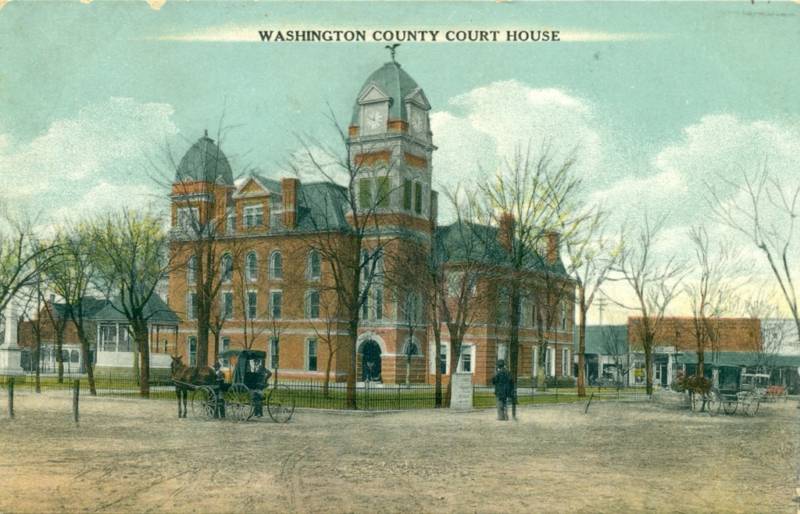history OF SANDERSVILLE, GEORGIA
Sandersville was settled around 1783 by Revolutionary War veterans who were awarded grants to Creek and Cherokee lands. Once known as “White Ponds,” the town grew up around the intersection of two Creek Indian trails and included a trading post owned by Mark Saunders (for whom the town was later named, with a spelling change).Saunders was instrumental in the town's early history.
 Washington County was established on February 25, 1784, as Georgia's 10th county and was named for U.S. president George Washington. The Georgia legislature named Sandersville the county seat of Washington County in 1796. Mr. Saunders donated part of his plantation to the county as a site for the first courthouse.
Washington County was established on February 25, 1784, as Georgia's 10th county and was named for U.S. president George Washington. The Georgia legislature named Sandersville the county seat of Washington County in 1796. Mr. Saunders donated part of his plantation to the county as a site for the first courthouse.
The settlement grew up around the store and survived after many post office communities in the county faded away. At one point it was home to a relay station for the stagecoach route from Louisville to the new capital in Milledgeville. It continued to grow and prosper through the years and by early 1800 was a bustling community. The town was incorporated by an act of the Georgia Legislature on Nov. 27, 1812.
Iin the 1840s the Central of Georgia Railroad proposed construction of a rail station in Sandersville, which was furiously opposed by local inhabitants. The railroad was therefore forced to locate in nearby Tennille, and that town prospered as a result.
The county courthouse was lost to fires in 1855 and again in 1864. A new courthouse was completed in 1868 and enlarged in the Victorian style in 1899. Before the turn of the 20th century, brick store buildings replaced wooden structures which burned over the years.
Religion played an important role in the early community. The first church in the area was constituted in 1790. Baptists and then Methodists later organized, and both denominations had founded churches by 1856. Around 1900, Catholic and Episcopal congregations were formed.
 Union general William T. Sherman and his troops came through Sandersville on Nov. 25, 1864, on their "March to the Sea." Sherman selected the Brown House as his headquarters. Two days later, when his army left Sandersville, Sherman ordered the courthouse and jail burned.
Union general William T. Sherman and his troops came through Sandersville on Nov. 25, 1864, on their "March to the Sea." Sherman selected the Brown House as his headquarters. Two days later, when his army left Sandersville, Sherman ordered the courthouse and jail burned.
Sandersville’s first public school opened in 1877, and in 1880 the first city hall was built. In 1893-94 Sandersville got an economic shot in the arm when the Sandersville Railroad was built to connect Sandersville to the city of Tennille and to the surrounding kaolin mines for loading fine white clay and other mining products. In the two decades between 1890 and 1910, Sandersville rapidly grew. Many brick buildings were built around the square, and stately homes were constructed on the fringes of Downtown.
Medicine also played a key role in the county's history. William Rawlings, a renowned surgeon, opened a hospital around 1895. Nurses were taught at Rawlings' Nurses Training School from 1903 to 1932. Operating on the Sandersville square for 65 years, the Rawlings Sanitarium moved to a new facility in 1961 and was renamed Washington Memorial Hospital. It is now the Washington County Regional Medical Center.
Stable cotton prices from about 1890 to the mid-1920s brought prosperity and fine homes to the area, many of which are still standing. As the agricultural economy declined, the kaolin industry grew.
Kaolin, a white, alumina silicate clay, is used in paper, medicines, paints, and many other products, all of which are shipped around the world. As Sandersville grew into kaolin's largest refiner, it became known as the "Kaolin Capital of the World." Five processing companies and numerous mines attract college-educated personnel, scientists, and geologists from many countries. An annual Kaolin Festival celebrates the importance of the resource.
At the end of the 20th century, kaolin was an $800 million business and Georgia's largest volume export. Mining companies have reclaimed and restored more than 80 percent of the land that has been stripped since 1969.
The Official State of Georgia Historical Plates, depicting events and people from the state's history, were designed by Sandersville native Louise Irwin in 1933. The plates are made in England by Wedgewood and are available for sale at local gift shops.
Organized in 1976, the Washington County Historical Society operates two museums, one in the old county jail, which is now the Old Jail Museum and Genealogical Research Center, and the Brown House Museum, which serves as the society's headquarters. Four districts are listed on the National Register of Historic Places, as are the Old City Cemetery and several other structures.
About two dozen historical markers are placed throughout the county, most relating to the Civil War. Listed on the National Register of Historic Places are the Francis Plantation, Washington County Courthouse, the Old City Cemetery, North Harris Street Historic District, and Charles Edward Choate Historic District.

